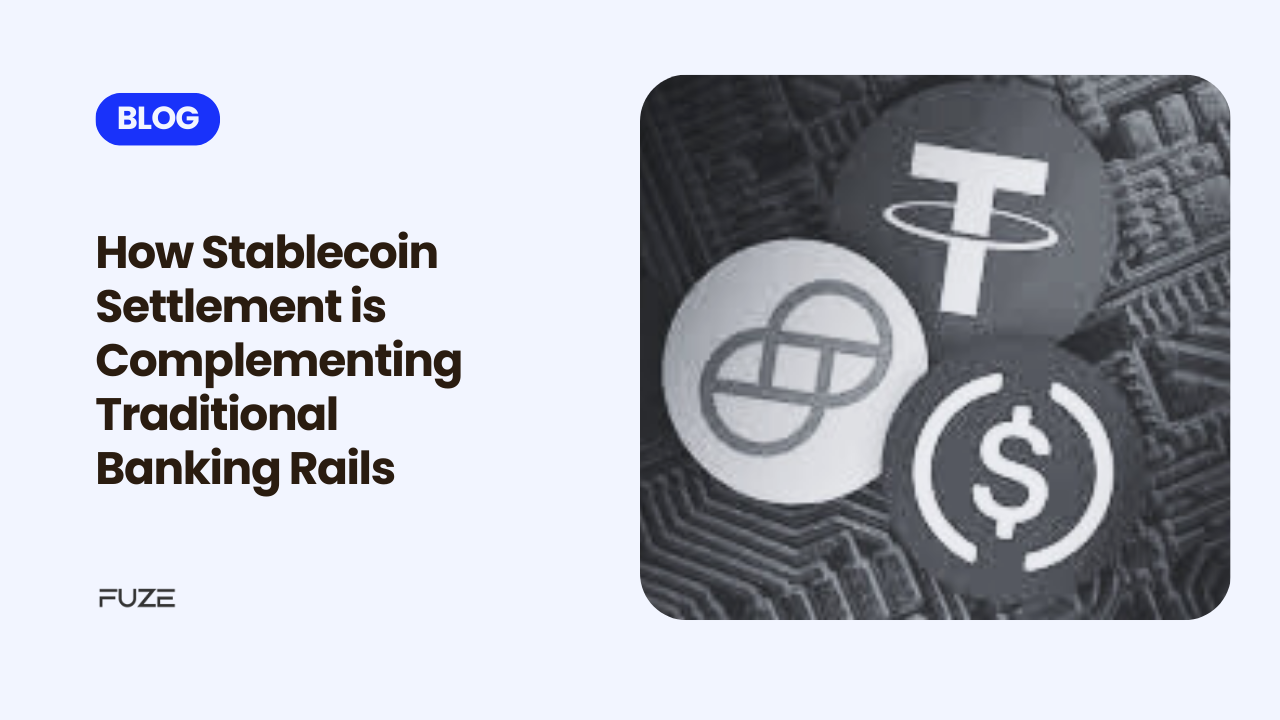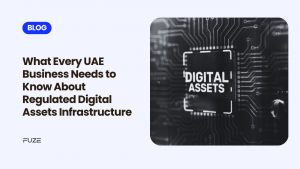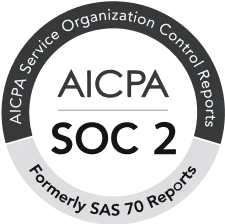In the world of financial infrastructure, traditional banking rails have long been the backbone of how money moves. From SWIFT to SEPA to ACH, these systems carry trillions of dollars across the globe every day, supporting everything from payroll to international trade. While reliable, they’re not without friction: delays, limited operating hours, high fees, and geographical fragmentation all add complexity and cost.
Stablecoins, blockchain-based digital assets pegged to fiat currencies like the US dollar or the euro, have emerged not as a replacement for traditional rails, but as a complementary layer. They fill critical gaps in speed, settlement finality, and accessibility. What’s unfolding is not a turf war between “crypto vs. fiat,” but a real evolution in how value moves where stablecoins and fiat rails are increasingly working in tandem.
In this blog, we’ll break down how stablecoin settlement is enhancing traditional financial infrastructure, the key use cases driving adoption, and what this convergence means for the future of money movement.
Legacy Rails: Trusted but Tethered
Traditional payment systems have earned their place in financial history. They’re deeply embedded in compliance frameworks, overseen by central banks, and trusted by institutions.
These systems were built in a pre-digital era and they come with limitations:
- Operating hours: Many clearing systems still follow business hours and take weekends off.
- Settlement delays: Cross-border wires can take 1–3 business days to clear, depending on intermediary banks.
- High costs: FX conversion, correspondent banking fees, and reconciliation expenses can eat into margins.
- Limited transparency: Businesses often don’t know where funds are in transit, especially across borders.
For banks and institutions looking to operate at internet speed, these rails can feel more like rails of bureaucracy.
Stablecoins: Internet-Native Money for a Borderless World
Stablecoins like USDC, USDT and PYUSD are designed for instant, borderless, 24/7 transfer of value. They run on public blockchains like Ethereum, Solana or Polygon, and can be transferred globally in seconds at minimal cost.
Here’s what makes them game-changing:
- Always-on settlement: No cut-off times, no holidays. Transactions clear instantly, even at 3 AM on a Sunday.
- Cost-efficiency: On-chain transfers are significantly cheaper than international wires, especially at high volume.
- Transparency: Transactions are traceable on-chain in real time.
- Programmability: Smart contracts enable advanced financial workflows like conditional payments, escrow or automated payouts.
These features make stablecoins particularly attractive to businesses operating across borders, especially in regions where banking infrastructure is slow, expensive, or fragmented.
The Role of Stablecoins in Modern Finance
While stablecoins offer clear advantages in settlement speed and cost, they’re not here to completely replace fiat rails. Instead, they’re becoming a complementary settlement layer, used in tandem with traditional systems, especially in the following ways:
1. Bridge Between Fiat and Crypto Systems
Stablecoins are the bridge between blockchain ecosystems and the traditional financial world. They make it easier for businesses and institutions to settle crypto-native transactions while still accounting in fiat.
At Fuze, we see this in action with partners across fintech, e-commerce, and institutional finance. A company might collect payments in stablecoins, settle instantly on-chain, and off-ramp to local fiat currencies, all in a single workflow. That’s a net benefit for the business and the end-user.
2. Faster Cross-Border Settlement
Remittance corridors, FX desks, and trading platforms increasingly use stablecoins to bridge time zones and banking hours. Let’s say a business in Dubai needs to pay a vendor in Turkey. Instead of initiating a SWIFT wire that takes two days and incurs fees, they can use USDT or USDC to settle near-instantly and convert to lira locally via an on/off-ramp partner.
This doesn’t mean they’re bypassing banks, it means they’re using banks more efficiently, by pairing fiat rails with blockchain rails depending on what the situation demands.
3. Liquidity Layer for Banks Themselves
Some forward-looking banks and financial institutions are now using stablecoins as a liquidity layer, especially for internal treasury operations, on-chain FX and settlement between branches across jurisdictions.
Banks are testing stablecoins for interbank transfers, enabling faster settlements with better visibility and auditability. This marks a shift in mindset, from seeing stablecoins as a threat, to recognizing them as infrastructure that unlocks efficiencies.
4. Backup Rail in Times of System Downtime
When a bank experiences a tech outage or a delay in its internal systems, stablecoins can act as a backup rail, especially in markets where time-sensitive settlement is critical.
We’ve seen this during public holidays, system upgrades, or geopolitical disruptions. Stablecoins are not bound by the same dependencies, making them a resilient alternative.
The Regulatory Catch-Up
For stablecoins to truly complement traditional banking rails at scale, regulation has to keep pace.
Fortunately, that’s starting to happen.
- The UAE is among the first to signal formal guidance around stablecoins as part of its Financial Infrastructure Transformation (FIT) program.
- The EU’s MiCA framework includes provisions for e-money tokens, paving the way for regulated stablecoins in the eurozone.
- In the US, bills are being drafted to establish clear guardrails for issuance, reserves, and redemption.
What This Means for Institutions
For banks, fintechs, and enterprises, the takeaway is clear: You don’t need to abandon traditional rails to benefit from blockchain. You just need to add a new layer, a stablecoin layer, that helps you move faster, settle smarter, and operate on global time.
Here’s what that could look like:
- Embedded stablecoin wallets within banking platforms
- Treasury rails that include stablecoin settlements for cross-border flows
- Stablecoin settlement APIs plugged into ERP systems or marketplaces
- Automated FX and off-ramp services to convert stablecoin receipts to fiat
This hybrid model gives you the best of both worlds, the compliance and trust of fiat, with the speed and agility of blockchain.
Stablecoins Are the Missing Puzzle Piece
The financial world doesn’t need another zero-sum disruption story. It needs practical, interoperable infrastructure that works across rails, across time zones, and across currencies.
Stablecoins offer just that. They don’t compete with traditional banking, they complete it. Moreover, in the hands of innovative institutions, they open the door to faster, cheaper, more intelligent financial workflows, from remittances to payroll to settlements and beyond.
At Fuze, we’re building the infrastructure to help businesses tap into this blended future, seamlessly bridging fiat and crypto in a way that’s compliant, scalable, and built for the real economy. Because when money moves better, everything else does too.
Disclaimer: Virtual assets carry significant risks, including high volatility and potential loss of your entire investment. They are not backed by governmental protections, and recourse may be limited in case of loss. Always assess your risk tolerance, fully understand the risks, and seek independent financial advice if needed before investing.
Frequently Asked Questions
1. Are stablecoins meant to replace traditional banking systems?
No. Stablecoins are not here to replace traditional banking rails like SWIFT or ACH. Instead, they serve as an additional settlement layer that complements existing systems, offering faster, borderless, and programmable value transfer alongside fiat infrastructure.
2. How do stablecoins benefit banks and financial institutions?
Stablecoins enable banks to settle transactions faster, especially during non-operating hours or across borders. They also serve as a liquidity tool for internal treasury functions, FX settlements, and even inter-branch transfers, improving capital efficiency and visibility.
3. Are businesses using stablecoins in real workflows today?
Yes. Across fintech, e-commerce, and institutional finance, businesses are using stablecoins to collect payments, settle instantly on-chain, and convert into local fiat, all in a single workflow. Fuze supports many such businesses in automating this hybrid flow.
4. What happens to compliance and regulation when stablecoins are involved?
Leading stablecoins like USDC and USDT work within regulatory frameworks, and providers like Fuze layer on robust compliance, AML, and KYB processes. Banks and businesses can integrate stablecoins without compromising on oversight or governance.
5. Why would a bank or business choose stablecoins over fiat for settlement?
Because they offer speed, cost savings, and availability. Unlike fiat rails limited by banking hours or geographical constraints, stablecoins settle near-instantly, 24/7. They’re especially valuable in remittances, cross-border B2B payments, and system downtimes.







